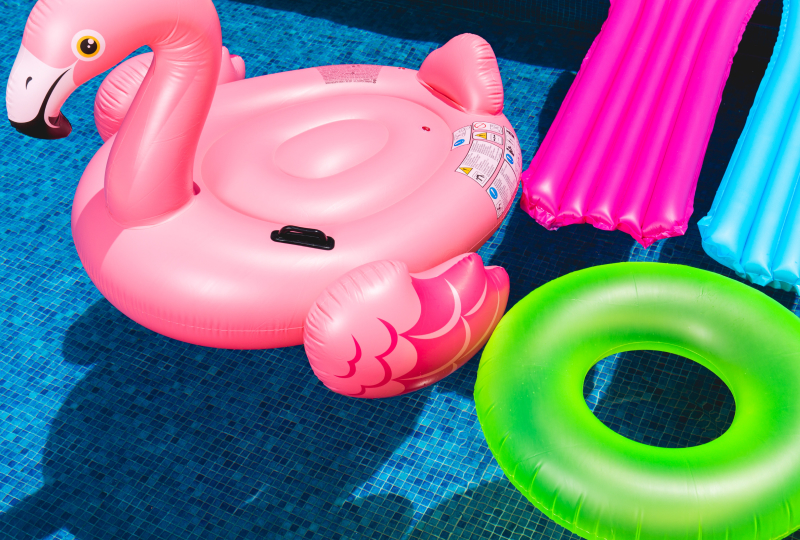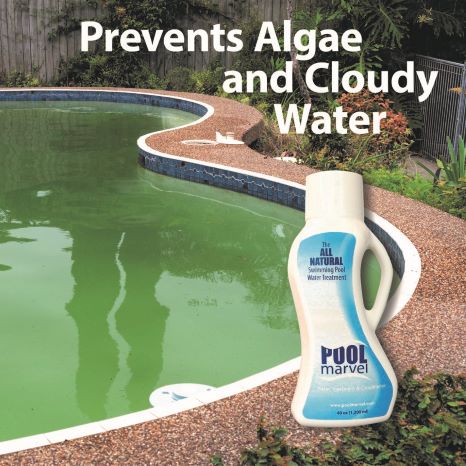
Pool Clarifier vs Pool Flocculant
Pool clarifier and pool flocculant are two chemical solutions that can be used to clear cloudy pool water.
As coagulant agents, they cause foreign debris particles that are typically too small to be removed by the filter to clump together into a larger mass. Pool flocculant creates larger clumps that sink to the bottom of your pool and require manual vacuuming to remove. Pool clarifiers create smaller clumps that the pool filter can remove.
Jump To Section:
What Is Pool Clarifier?
How Long Does It Take for Pool Clarifier To Work?
What Is Pool Flocculant?
Clarifier Versus Flocculant: Which Is Better?
Benefits of Pool Flocculant
Drawbacks of Pool Flocculant
Benefits of Pool Clarifier
Drawbacks of Pool Clarifier
How To Use Pool Flocculant
How To Use Pool Clarifier
Homemade Pool Clarifier and Pool Flocculant
What is Pool Clarifier?
A swimming pool clarifier is a concentrated liquid mixture that contains polymers. These chain-like molecules act as coagulant agents on the foreign debris in your cloudy water. By clumping tiny particles together, the clarifier allows your filter to remove them from your pool water through its normal filtration process.
Using a pool water clarifier is an easy solution for clearing up cloudy pool water but can take some time to work.
How Long Does It Take For Pool Clarifier To Work?
After adding a pool clarifier to your pool water, it can take 2-3 days until cloudiness clears up.
You can swim in your pool approximately 20 minutes following the application of a pool clarifier. Swimming can help improve circulation, stir up the particles, and speed up the clarifying process.
What is Pool Flocculant?
Pool flocculant, also known as pool floc, is a powdered chemical that you can use to clear a cloudy pool.
Like a pool clarifier, pool floc acts as a coagulant by binding tiny particles in your pool to thicken and clump together. However, these larger clumps sink to your pool’s floor and require manual vacuuming for removal rather than a filtration process.
Pool flocculant provides a faster, more effective way to clear up your pool water – but requires more physical effort.
Clarifier Vs Flocculant: Which Is Better?
Choosing between a clarifier and flocculant will depend on how quickly you need to clear your pool water and the amount of work you’re willing to do.
Benefits of Pool Flocculant
A pool flocculant works almost immediately to clear cloudy pool water, making it ideal for pool emergencies. Pool floc is suitable for all types of cloudy pool water, from mild to severe situations.
Pool flocculant is an effective coagulant and can take less than 24 hours to clear up cloudy pool water. It needs 8-16 hours to coagulate contaminants in your pool before you can vacuum them out. The particles causing the cloudy water remain clumped together until you manually remove them.
Drawbacks of Pool Flocculant
Manually removing the clumps with a pool vacuum requires more physical work and patience from the pool owner.
You’ll need to bypass your pool filter and vacuum the pool on the waste setting during the process. As you vacuum, you’ll remove water from your pool that will require replacing.
Unless there’s a custom plumbing setup to bypass the filter, flocculant is unsuitable for a cartridge filter system.
Benefits of Pool Clarifier
Pool clarifiers require minimal effort from pool owners. After adding a clarifier, you don’t need to do anything other than balance your pool water chemistry. Pool clarifiers can be used with all types of filter systems.
Although they’re best suited for mild to low cloudiness levels, clarifiers can be used even when your pool’s not noticeably cloudy. They’re a great option to use after many swimmers use your pool or when you want your pool to look a little extra sparkly.
Pool clarifiers improve pool filter efficiency, enabling it to catch more contaminants. Unlike floc, you don’t remove water when using a pool clarifier. This creates savings on your water bill and is more environmentally friendly.
Drawbacks of Pool Clarifier
A pool clarifier’s most significant disadvantage is its speed of action, requiring up to 2-3 days to clear pool water. It’s also not as effective as clearing up cloudy pools as pool flocculant.
After using a pool clarifier, you’ll need to thoroughly clean the pool filter to remove the clumped particles.
Depending on the type of clarifier used, too much clarifier can increase the pH level. This can make chlorine less effective. Measure your clarifier carefully to ensure this does not happen.
How To Use Pool Flocculant
1. Set Filter to Recirculate
First, set your sand or DE filter to the recirculate setting so that the flocculant won’t ruin your filter.
2. Test and Balance the pH
Test the water chemistry and then balance it accordingly. The water should have a pH level of 7.4 to 7.6 before adding any flocculant.
3. Prepare and Add the Flocculant
Prepare the flocculant by following the instructions closely. Use a pool volume calculator if you don’t know the amount of water in your swimming pool.
Pour the prepared flocculant into your swimming pool around its edges.
4. Circulate the Flocculant
Run your pool pump for several hours to thoroughly circulate the flocculant in your pool.
5. Wait
Shut off the pool filter for at least 8 hours so that the water is still and the flocculant can settle. You’ll notice some particle clumps forming and sinking to the bottom during this time.
6. Vacuum Particle Clumps Out of Pool
After the flocculant has settled, you can remove the clumps with your manual vacuum. Set your pool filter to the waste setting. In the absence of a multiport valve, open your filter’s drain port and allow the water to exit while vacuuming.
7. Replace Any Lost Water
Use a garden hose to increase your pool’s water level back to the desired level.
8. Test and Balance Water
Test and rebalance your water chemistry.
9. Backwash the Pool Filter
Backwash your filter to remove all sediment and leftover chemicals.
How To Use Pool Clarifier
1. Test and Balance the pH
Test the water chemistry and then balance it accordingly. The water should have a pH level of 7.4 to 7.6 before adding any clarifier.
If you have high levels of combined chlorine or any algae, you’ll need to complete a shock treatment.
2. Prepare and Add the Clarifier
Read the manufacturer’s instructions to determine the amount of clarifier to put in your pool water. Ensure you use the correct amount of clarifier for your pool’s volume.
Add the clarifier to your pool by pouring it around your pool’s outer edges.
3. Run Your Filter
Turn on your pool filter to start the circulation and filtration process. Keep your filter system running 24/7 until the cloudiness goes away.
4. Clean Your Filter and Re-Test Your Water
After 2-3 days, your water should be clearer. Clean or backwash your filter, test your water, and balance it accordingly.

Homemade Pool Clarifier And Pool Flocculant
The best way to have a clear pool naturally is to use the following products to maintain water balance and clean your pool. While they will not clear up a cloudy pool, they will help prevent cloudy water.
Baking Soda
Baking soda can increase the alkalinity, lower the amount of acid, and clean your pool naturally.
To Use: Brush the walls and base of your pool with a paste that combines baking soda with water.
Muriatic Acid
Muriatic acid helps reduce a pool’s alkalinity and neutralize the pH level of pool water. Its deep cleaning effect is particularly suited for concrete or gunite pools.
To Use: Fill a five-gallon bucket with clean water, then add approximately one-tenth as much muriatic acid. Slowly add the mixture around the pool’s perimeter.
White Vinegar
White vinegar can help get a shiny pool surface and clean debris on the sides of the pool.
To Use: Mix white vinegar with water in equal parts. Apply the solution with a sponge to wipe off calcium deposits and clean metal surfaces.
Bleach
The sodium hypochlorite in bleach increases the amount of chlorine in pool water, cleans the pool of debris, and raises the free chlorine value.
To Use: Apply bleach to the pool’s sides, floor, and deck to remove debris.
Borax
Borax can increase the pH level and balance pool water.
To Use: Read the label to understand the exact pH value of the borax before adding it directly to the pool water. Be careful not to overdo it.
Rubbing Alcohol
Rubbing alcohol mixed with water effectively cleans pool surfaces of stubborn dirt and balances the pH level.
To Use: Mix 70 percent rubbing alcohol with 30 percent water. Apply the solution to steel or tile surfaces to remove any debris.


